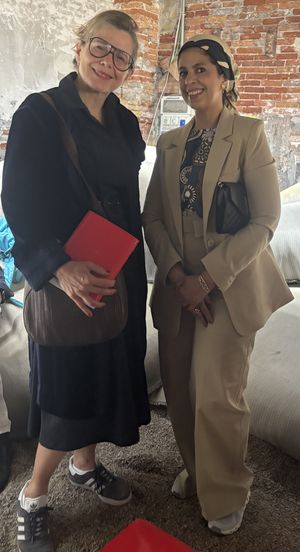Planetary intelligence and data-driven design: Dispatch from the Venice Architecture Biennale 2025

 This year’s Venice Architecture Biennale didn’t just showcase buildings and QR codes—it invited us to reconsider what intelligence means in a world shaped by climate volatility, technological acceleration, and planetary interdependence.
This year’s Venice Architecture Biennale didn’t just showcase buildings and QR codes—it invited us to reconsider what intelligence means in a world shaped by climate volatility, technological acceleration, and planetary interdependence.
Titled Intelligens. Natural. Artificial. Collective., the Biennale—curated by Carlo Ratti—explored how architecture can evolve when it draws from multiple forms of intelligence: biological, computational, and collective.
It’s not every day you attend a show where wind towers, neural networks, and planetary cosmology are part of the same architectural vocabulary.
But this Biennale didn’t aim for coherence—it embraced the complexity of the world we live in.
Architectures of adaptationIn Ratti’s words, architecture is at a turning point: it must shift from mitigation to adaptation. This demands new tools and new mindsets—and, as the Biennale made clear, new ways of working across disciplines. From AI-driven design labs to ancestral cooling systems, projects responded not with singular visions but with plural intelligences.
One of the standout thematic clusters, Robotic Constructs, pushed this to its technological frontier: human-machine alliances, responsive environments, and real-time feedback loops that treat buildings as adaptive organisms. These are not the smart cities of yesterday’s PowerPoints—they’re algorithmic ecosystems in the making. But it wasn’t just machines that caught the eye.
Am I a strange loop?Standing before ALTER3 feels like meeting a modern oracle. With 43 air-powered muscles and cameras in each eye, the robot responds to your words not just with generated speech, but with expressive Italian-style gestures.
Powered by a large language model (LLM) fine-tuned on the ecology of the Venice lagoon and its adaptation history, ALTER3 offers conversations on climate, fragility, and possible futures.
In fact, I had hoped ALTER3 would write this very article for me. I tried. (There’s video proof.) But even recursive meta-loops have their limits. Let’s just say: for now, I’m still doing the typing. But I have his business card.

I did not accept to have a cup of coffee filtered straight from the Venetian lagoon. I passed. And opted instead for a Morning Bellini at the Bahrain Pavilion. Good choice.
Bahrain: Tradition as intelligence The Bahrain Pavilion was among the most quietly radical—and effective. I ran into Wafa Alghatam, a long-time urban strategist who had been involved with this remarkable project from its earliest stages—contributing architectural and urban knowledge of Bahrain, helping shape the pavilion’s conceptual approach, and supporting the team with spatial data and research.
The Bahrain Pavilion was among the most quietly radical—and effective. I ran into Wafa Alghatam, a long-time urban strategist who had been involved with this remarkable project from its earliest stages—contributing architectural and urban knowledge of Bahrain, helping shape the pavilion’s conceptual approach, and supporting the team with spatial data and research.
She was visibly enthusiastic, and rightly so. Bahrain would later take home the Golden Lion for Best National Participation. Golden Lion for best National Participation to the Kingdom of Bahrain: The Pavilion offers viable proposal for extreme heat conditions.
As the designers explain, “Architecture must address the dual challenges of environmental resilience and sustainability. The ingenious solution can be deployed in public spaces and in locations where people must live and work outdoors in conditions of extreme heat. The pavilion uses traditional methods of passive cooling typical of the region and reminiscence of wind towers and shaded courtyards.
That storytelling came through clearly. The pavilion proposed low-tech, high-impact solutions for extreme heat—reimagining passive cooling systems through traditional forms like wind towers and shaded courtyards. Data-driven design can be embodied knowledge, passed across generations.
The next earth: Where computation meets cosmologyIn a Biennale filled with provocations, The Next Earth—a Collateral Event by Berggruen and MIT Architecture—offered perhaps the most intellectually expansive frame.
The Noocene explored planetary cognition: the idea that Earth, through computational evolution, is becoming partly self-aware. From the Antikythera mechanism (circa 200 BC) to emergent AI, the show traced how tools of measurement—from dials to datasets—have shaped how we perceive and design the world. “Fire apes teaching rocks to think fast,” one caption read. It stuck with me.
MIT Architecture’s Climate Work presented 37 speculative projects on climate, material systems, and planetary futures. These weren’t just architecture projects—they were models for world-building. From realigning supply chains to rethinking energy flows, each prototype asked: how do we compute a livable planet?
Toward a collective data consciousnessFor the Data Natives community, this Biennale offers an insight into how data is becoming planetary infrastructure. No longer just a means of optimization or prediction, data is emerging as a medium of design—one that connects cosmology to climate tech, algorithms to artisanship.
Intelligence isn’t singular or static. It’s adaptive, networked, and often, surprisingly human. And as architecture begins to think like an ecosystem—and build like a system—it invites us all to think differently about what we build, and what builds us.
The age of Intelligens is here. And it’s not just about smart cities. It’s something bigger, you could call wise systems.
Final thought: Get thereThis Biennale isn’t just for the architecture nerds. It’s for anyone wondering how we live on a changing planet without losing our minds—or our humanity. So if you’re into climate tech, AI dreams, ancient cooling tricks, or robots that throw Italian shade—Venice is calling. Bring walking shoes. And maybe skip the coffee.
